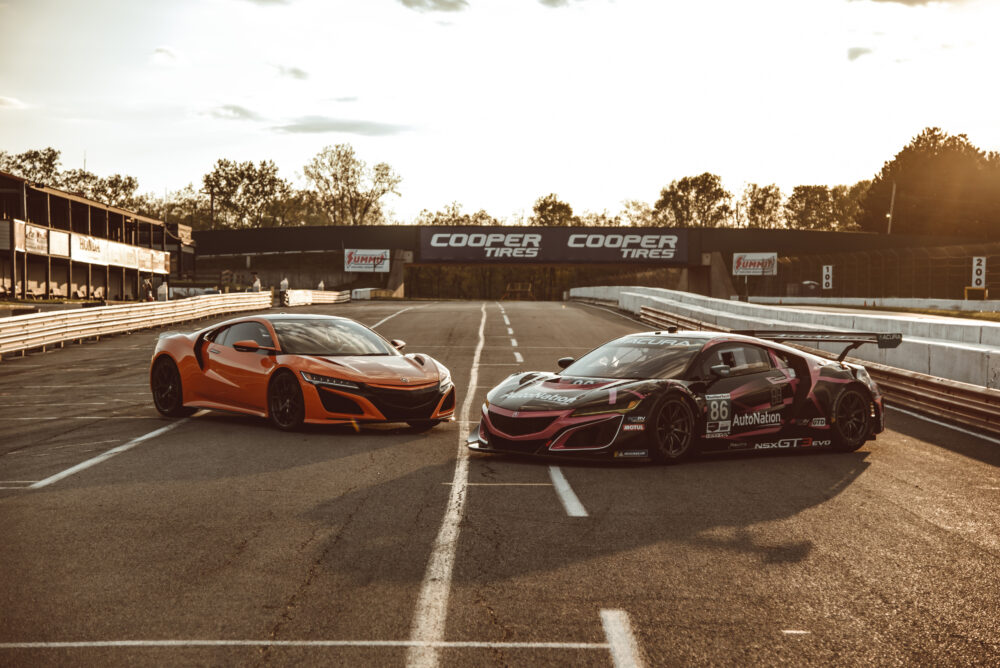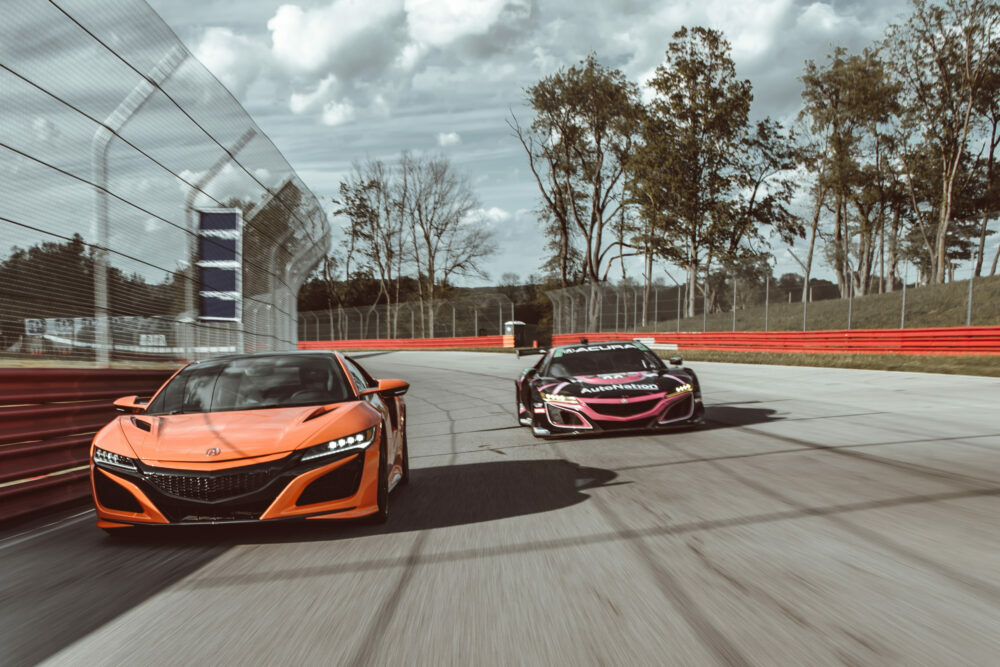New Video Pits the Production NSX vs the NSX GT3 Evo
Trent Hindman and the Acura NSX GT3 Evo are putting together an impressive pedigree on the track.
In a thrilling video from Acura News, professional GT3 racer Trent Hindman details the differences and similarities between the production model NSX and its race-bred equivalent GT3 Evo at the Mid-Ohio Sports Car Course.
The Acura NSX first burst onto the automobile scene in February of 1989, when it debuted in Chicago, Illinois. Since then it has maintained a legendary status amongst car fanatics. It was the first supercar to come out of Japan to rival the Italian powerhouses. Its design was a breath of fresh air for the automotive world. Killer looks, phenomenal handling, and insatiable power; All with the reliability expected of Honda and at a comparatively low cost.
The first generation of NSX ran from 1990 to 2005 when its production was halted. With the resurrection of the NSX in 2016, the automotive world was treated to a fresh design that had taken a significant departure from its previous model. The second-gen NSX utilizes a 3.5-liter twin-turbo V6 mated to a 9-speed dual-clutch transmission. On top of that, the NSX houses a three-motor Sport Hybrid SH-AWD® system, which delivers both positive and negative torque to the front wheels independently for increased handling performance. Altogether, these systems work to produce an impressive 573 horsepower and 476 lb-ft of torque, capable of launching its lightweight body from 0-60 in a blistering 2.92 seconds.
But when compared to its GT3 series sibling, the similarities are more prevalent than one might first imagine. Hindman shares how the production NSX was clearly designed with motorsport in mind from start to finish. Its developers intended that racing would be an integral part of the new NSX’s DNA.
“We knew from the outset that the second-generation NSX would be tested at the highest limits on track…Competitive racing was an essential consideration during NSX development, which influenced critical decisions we made regarding the car’s fundamental design.” said Ted Klaus, who served as the global development leader for the second-gen NSX and now serves as president of Honda Performance Development.
Throughout the video, Hindman communicates these similarities by testing each vehicle and explaining their slightly different compositions and specifications. Hindman showcases each vehicle’s prowess in 0-60, user-friendliness, braking, and overall lap speed tests.
Crafting the GT3 Evo to meet GT racing regulations took little work according to Hindman, both being assembled at Acura’s Performance Manufacturing Center (PMC) in Marysville, Ohio – a first of its kind plant utilizing 100% robotic MIG welding to construct its automotive bodies- and sharing nearly 80% of component parts. While the GT3 Evo must forgo the hybrid powertrain and AWD to comply with GT racings RWD requirements, it still utilizes the same 3.5l V6 engine. Other small changes include an interior stripped of all non-essentials, iron brake rotors, carbon fiber body panels, a 6-speed sequential gearbox, and a large rear wing-wich provides over 500% more downforce. The GT3 Evo puts out a comparable 550hp and 475lb ft of torque all while shaving nearly 1,100 lbs.
With the road-ready NSX’s already robust platform, it’s not hard to see why the race-tuned GT3 Evo is dominating on the circuit. Some of its many accomplishments include six wins in the Blancpain GT World Challenge America series, current points lead in the IMSA WeatherTech Sportscar Championship, and a class lead in the Japanese Super GT series. Many more impressive performances have been added in several other GT series across the globe and standalone races. The GT3 Evo has no doubt proven itself to be a staunch competitor.
Trent Hindman, while only 23 years old, is a well-established contender on the circuit. He flourished as a kart racer as a child, eventually earning a national karting championship. Hindman went on to race formula cars, then sports cars becoming the youngest driver to win a Michelin Pilot Challenge championship at the age of 19. Hindman now pilots the NSX GT3 for Meyer Shank Racing in the IMSA Weathertech Sportscar Championship (GTD) where he currently leads the points standings. Hindman also has two second-place finishes in the NSX GT3 at Petit Le Mans and Daytona.
While not quite the same animal, Hindman proved the street-going NSX more than capable of holding its own on the track with the GT3 Evo; something entirely out of the equation for a vast majority of high production vehicles. With continued success both on and off the track, the second-gen NSX is sure to further cement the NSX name as an exotic legend.
Additional Specs for the NSX and NSX GT3 Evo
| Specs | NSX | NSX GT3 Evo |
| Starting MSRP | $157,500 | €465,0003 (Approx. $525,000) |
| Engine | Twin Turbo 3.5 Liter 75° V6 | ß |
| Transmission | 9-Speed DCT | 6-Speed Sequential |
| Electric Motors | 3 | – |
| Drivetrain | SH-AWD® | RWD |
| Total System HP / Torque | 573 / 476 | 550 / 475 |
| Est. Acceleration 0-60 | 2.92 secs | 4.35 secs |
| Body Structure | Aluminum Intensive Multi Material | ß |
| Race Ready Roll Cage | – | 25CrMo TIG Welded |
| Exterior Body Panels | Aluminum and Composite | Carbon Fiber |
| Brakes | Brembo Steel Rotors FR: 368 mm / RR: 361 mm Optional: Brembo Carbon Ceramic FR: 381 mm / RR: 361 mm |
Brembo Steel Rotors FR: 390 mm / RR: 355 mm |
| Wheels | Forged Aluminum FR: 19″ x 8.5″ /Â RR: 20″ x 11″ |
Center Locking, Forged Aluminum FR: 18″ x 12″ /Â RR: 18″ x 13″ |
| Tires | Continental Sport Contact 6 FR: 245/35-19 / RR: 305/30-20 Optional: Pirelli Trofeo R |
Brand varies with Race Series FR: 315/46-18 / RR: 325/48-18 |
| Wheelbase | 2,630 mm | ß |
| Overall Length | 4,470 mm | 4,612 mm |
| Overall Width | 2,217 mm (w/ mirrors) | 2,040 mm (w/o mirrors) |
| Front Track | 1,655 mm | 1,715 mm |
| Rear Track | 1,618 mm | 1,687 mm |
| Weight | 3,878 lbs. | Est. 2,800 lbs.4 |






